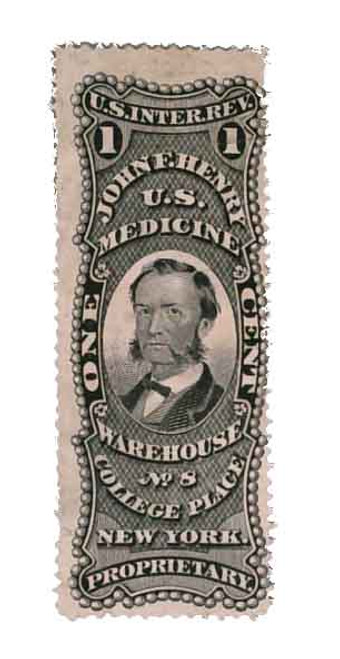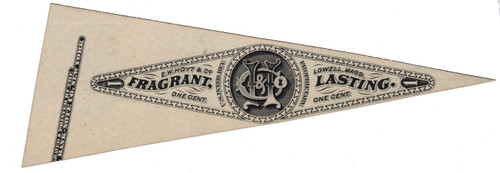
# RT7c - 1877-78 E.W. Hoyt & Co., 1c black, pink paper
US #RT7c
1877 E.W. Hoyt & Co. Private Die Perfumery Tax Stamp
• Covered the Proprietary Tax rate for perfume
• Produced by famous cologne company E.W. Hoyt & Co. (cologne that’s still on sale as of 2024)
• Printed on pink paper, adding to scarcity and desirability
Stamp Category: Private Die Proprietary Tax Stamp
Company Using the Die: E.W. Hoyt & Co. of Lowell, Massachusetts
Value: 1¢ Perfume Tax
Issue Year: 1877 (this is the date the company’s private die was approved for use)
Printed by: Butler and Carpenter of Philadelphia, Pennsylvania
Type: Pink paper
Perforations: Die cut
Color: Black ink
Shape: Diamond
Why the stamp was issued: To cover the 1¢ tax required to be paid on E.W. Hoyt & Co.’s 25¢ trial size bottle of German cologne.
About the stamp design: Designed in a rounded diamond shape with ornate E.W. Hoyt & Co. logo in the center and text on either side reading “E.W. Hoyt & Co. Lowell, Mass,” “Fragrant, Lasting,” “One Cent,” “U.S. Inter. Rev. Proprietary.” Two numeral “1’s” are located at the far right and left points of the diamond and the whole stamp has a decorative border. All design details in black ink.
Special design details: This particular variety was printed on pink paper. This paper was only in use from 1877-1878, so only a limited number of stamps were printed on it, adding to its scarcity today.
The oblong diamond shape of this stamp was necessary to allow it to be affixed to a bottle of perfume (“German cologne” according to E.W. Hoyt & Co.). Opening the bottle would almost certainly destroy the stamp, making used examples more difficult to come by than unused.
About Butler & Carpenter: This company (located in Philadelphia, Pennsylvania) printed the vast majority of Private Die Proprietary Tax stamps as well as Revenue stamps for the US government.
History the stamp represents: The United States issued its first Revenue stamps in 1862 to help fund the Civil War (although the stamps continued to be issued long after the war ended). This included Proprietary Tax stamps covering taxes on medicines, matches, perfumes, and much more. The taxes required for each different type of item were laid out in Schedule C of the 1862 Tax Act.
Later on, the federal government began offering tax discounts to manufacturers who produced their own Proprietary Tax stamps. The manufacturers paid for the engraving and printing expenses while the printing dies were controlled and approved by the US Department of the Treasury. Since each individual company determined the design of their stamps, they often used them as miniature advertisements for their products.
E.W. Hoyt & Co. was known for its perfume called “Hoyt’s German Cologne.” They began selling it in 1870 in iconic glass bottles which included the product and company name inscribed into the glass itself. (These bottles are collectibles in their own right.). E.W. Hoyt & Co. produced perfume in trial-sized bottles as well as medium and large sizes. They charged 25¢ for trial, 50¢ for medium and $1 for large. While it has changed over the years, the perfume was still available for sale as of 2024.
To learn more about the history of E.W. Hoyt & Co., click here.
US #RT7c
1877 E.W. Hoyt & Co. Private Die Perfumery Tax Stamp
• Covered the Proprietary Tax rate for perfume
• Produced by famous cologne company E.W. Hoyt & Co. (cologne that’s still on sale as of 2024)
• Printed on pink paper, adding to scarcity and desirability
Stamp Category: Private Die Proprietary Tax Stamp
Company Using the Die: E.W. Hoyt & Co. of Lowell, Massachusetts
Value: 1¢ Perfume Tax
Issue Year: 1877 (this is the date the company’s private die was approved for use)
Printed by: Butler and Carpenter of Philadelphia, Pennsylvania
Type: Pink paper
Perforations: Die cut
Color: Black ink
Shape: Diamond
Why the stamp was issued: To cover the 1¢ tax required to be paid on E.W. Hoyt & Co.’s 25¢ trial size bottle of German cologne.
About the stamp design: Designed in a rounded diamond shape with ornate E.W. Hoyt & Co. logo in the center and text on either side reading “E.W. Hoyt & Co. Lowell, Mass,” “Fragrant, Lasting,” “One Cent,” “U.S. Inter. Rev. Proprietary.” Two numeral “1’s” are located at the far right and left points of the diamond and the whole stamp has a decorative border. All design details in black ink.
Special design details: This particular variety was printed on pink paper. This paper was only in use from 1877-1878, so only a limited number of stamps were printed on it, adding to its scarcity today.
The oblong diamond shape of this stamp was necessary to allow it to be affixed to a bottle of perfume (“German cologne” according to E.W. Hoyt & Co.). Opening the bottle would almost certainly destroy the stamp, making used examples more difficult to come by than unused.
About Butler & Carpenter: This company (located in Philadelphia, Pennsylvania) printed the vast majority of Private Die Proprietary Tax stamps as well as Revenue stamps for the US government.
History the stamp represents: The United States issued its first Revenue stamps in 1862 to help fund the Civil War (although the stamps continued to be issued long after the war ended). This included Proprietary Tax stamps covering taxes on medicines, matches, perfumes, and much more. The taxes required for each different type of item were laid out in Schedule C of the 1862 Tax Act.
Later on, the federal government began offering tax discounts to manufacturers who produced their own Proprietary Tax stamps. The manufacturers paid for the engraving and printing expenses while the printing dies were controlled and approved by the US Department of the Treasury. Since each individual company determined the design of their stamps, they often used them as miniature advertisements for their products.
E.W. Hoyt & Co. was known for its perfume called “Hoyt’s German Cologne.” They began selling it in 1870 in iconic glass bottles which included the product and company name inscribed into the glass itself. (These bottles are collectibles in their own right.). E.W. Hoyt & Co. produced perfume in trial-sized bottles as well as medium and large sizes. They charged 25¢ for trial, 50¢ for medium and $1 for large. While it has changed over the years, the perfume was still available for sale as of 2024.
To learn more about the history of E.W. Hoyt & Co., click here.











